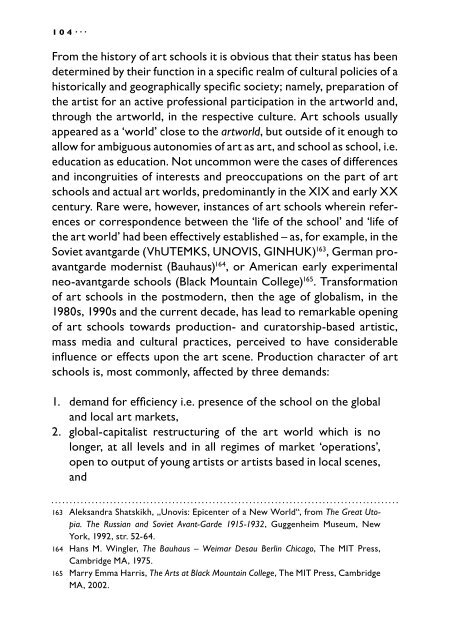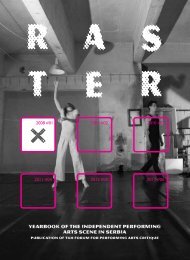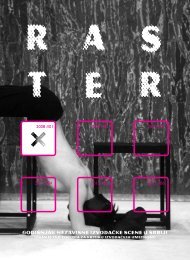Miško Šuvaković Epistemology of Art - TkH
Miško Šuvaković Epistemology of Art - TkH
Miško Šuvaković Epistemology of Art - TkH
You also want an ePaper? Increase the reach of your titles
YUMPU automatically turns print PDFs into web optimized ePapers that Google loves.
104··· ··· 105<br />
From the history <strong>of</strong> art schools it is obvious that their status has been<br />
determined by their function in a specific realm <strong>of</strong> cultural policies <strong>of</strong> a<br />
historically and geographically specific society; namely, preparation <strong>of</strong><br />
the artist for an active pr<strong>of</strong>essional participation in the artworld and,<br />
through the artworld, in the respective culture. <strong>Art</strong> schools usually<br />
appeared as a ‘world’ close to the artworld, but outside <strong>of</strong> it enough to<br />
allow for ambiguous autonomies <strong>of</strong> art as art, and school as school, i.e.<br />
education as education. Not uncommon were the cases <strong>of</strong> differences<br />
and incongruities <strong>of</strong> interests and preoccupations on the part <strong>of</strong> art<br />
schools and actual art worlds, predominantly in the XIX and early XX<br />
century. Rare were, however, instances <strong>of</strong> art schools wherein references<br />
or correspondence between the ‘life <strong>of</strong> the school’ and ‘life <strong>of</strong><br />
the art world’ had been effectively established – as, for example, in the<br />
Soviet avantgarde (VhUTEMKS, UNOVIS, GINHUK) 163 , German proavantgarde<br />
modernist (Bauhaus) 164 , or American early experimental<br />
neo-avantgarde schools (Black Mountain College) 165 . Transformation<br />
<strong>of</strong> art schools in the postmodern, then the age <strong>of</strong> globalism, in the<br />
1980s, 1990s and the current decade, has lead to remarkable opening<br />
<strong>of</strong> art schools towards production- and curatorship-based artistic,<br />
mass media and cultural practices, perceived to have considerable<br />
influence or effects upon the art scene. Production character <strong>of</strong> art<br />
schools is, most commonly, affected by three demands:<br />
1. demand for efficiency i.e. presence <strong>of</strong> the school on the global<br />
and local art markets,<br />
2. global-capitalist restructuring <strong>of</strong> the art world which is no<br />
longer, at all levels and in all regimes <strong>of</strong> market ‘operations’,<br />
open to output <strong>of</strong> young artists or artists based in local scenes,<br />
and<br />
163 Aleksandra Shatskikh, „Unovis: Epicenter <strong>of</strong> a New World“, from The Great Utopia.<br />
The Russian and Soviet Avant-Garde 1915-1932, Guggenheim Museum, New<br />
York, 1992, str. 52-64.<br />
164 Hans M. Wingler, The Bauhaus – Weimar Desau Berlin Chicago, The MIT Press,<br />
Cambridge MA, 1975.<br />
165 Marry Emma Harris, The <strong>Art</strong>s at Black Mountain College, The MIT Press, Cambridge<br />
MA, 2002.<br />
3. restructuring <strong>of</strong> the art world in two basic and determinate<br />
sub-systems <strong>of</strong> artistic production: market and fundraising sustenance<br />
<strong>of</strong> art.<br />
Production features <strong>of</strong> work and effects <strong>of</strong> a school are determined<br />
by fundraising modes (state, private, or corporate capital). Thus, artistic<br />
production transforms from the realm <strong>of</strong> creation <strong>of</strong> art works<br />
into the realm <strong>of</strong> art projects, whereas the very canon <strong>of</strong> crafts- and<br />
poetics-based traditional art education becomes refocused into the<br />
realm <strong>of</strong> projective education, incorporating production/postproduction<br />
media- or performance-based work, in synchrony with curatorial,<br />
managerial, and theoretical discursive output. In other words,<br />
a contemporary art school engaged in liberal-productive or (to the<br />
contrary) critical-emancipatory work, becomes a micro-physical and<br />
micro-political ‘image’, a simulacrum <strong>of</strong> the art world with particular<br />
regimes <strong>of</strong> creative/productive, production/postproduction, curatorial/economic,<br />
organizational, and theoretical/interpretative work in<br />
culture. Resistance to this conceptual transformation <strong>of</strong> art schools<br />
features in dispositions towards recycling or revision <strong>of</strong> traditional<br />
and, <strong>of</strong>ten, ethnically-based and disciplinary oriented art schools<br />
(academies, conservatories) or radical practices <strong>of</strong> self-organization 166<br />
and self-education 167 in the realm <strong>of</strong> organizations (in managerial and<br />
economic terms) relatively independent from local governments and<br />
global corporate capital: namely, the market.<br />
Internal structure <strong>of</strong> the school can be outlined in the following institutional<br />
modes <strong>of</strong> regulation <strong>of</strong> the school’s vita activa: platform, curriculum,<br />
study program, class, agency, terminal, access, and paradigm.<br />
Platform <strong>of</strong> the art school is comparatively regulated series <strong>of</strong> intentional<br />
and unintentional cohesive standards underlying the power/<br />
authority and judgement on art, perceived as reality <strong>of</strong> the school<br />
166 „Self-organization issue“, <strong>TkH</strong> no. 11, Belgrade, 2006.<br />
167 „Self-education – Goat Tracks <strong>of</strong> Self-education“, <strong>TkH</strong> no. 15, Belgrade, 2008;<br />
„Self-education – Self-Managed Educational System in <strong>Art</strong> (s-o-s-project)“, <strong>TkH</strong><br />
no. 14, Belgrade, 2007.







